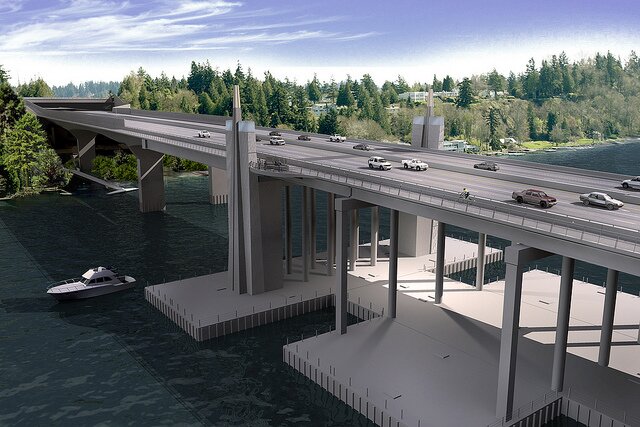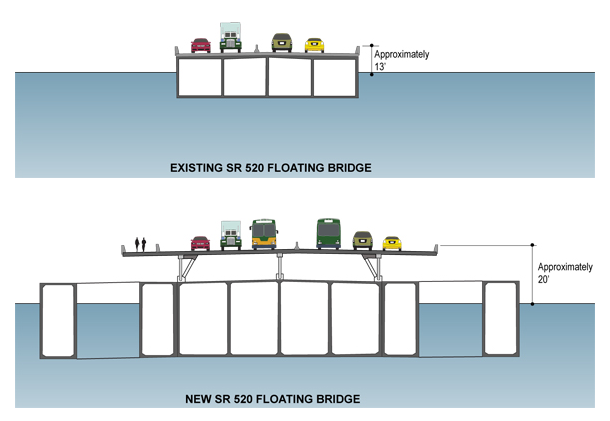
The 6-lane expansion of the SR 520 bridge can’t hardly get a legal break without another challenge popping up. First of all, Washington State Patrol troopers have been ticketing overweight trucks crossing the bridges around Aberdeen. The Daily World reports: “A single over-the-weight limit trip on the Chehalis River Bridge can cost a trucking company upwards of a $17,000 fine.” Repeated fines can lead to an impounded truck.
Brundage Bone Concrete Pumping truckers, contracted to work on the 520 pontoons, were having to drive a half-hour out of their way to avoid the Chehalis River Bridge, until owner Jim Wright secured a weight-limit exemption from the Washington Department of Transportation. The new Montlaker site cried foul at WSDOT acting so expeditiously to waive limits for its own project, without granting them equally to other concerns.
In his blog post at the Seattle Times, Mike Lindblom writes: “On the $4.65 billion Highway 520 project, the state spent 14 years and $263 million from 1997-2011 on outreach, designs and preliminary engineering. For $263 million, the state could have funded a new bridge in Grays Harbor, with millions left over.”
Now, the Coalition for a Sustainable 520 has filed their opening brief in a federal suit against WSDOT. In an email to supporters, Fran Conley outlines the arguments that the brief makes:
It points out that federal and state laws require the agencies to evaluate reasonable alternatives, and that this was not done… For instance, adequate review was not done on a tolled, transit-optimized 4 lanes. It points out that federal and state law require avoidance of taking public land, and that adequate analysis of alternatives to taking our beautiful waterways and natural areas was not done. It points out that the state did not do a cost-benefit analysis that is required by state law and that is supposed to inform the decision-makers.
The Coalition admits that “the existing 4-lane bridge is in danger of collapse” in their brief, but argues that it’s stretching truth and necessity to call the new 520 project “6-lane” when it tops out at 12 lanes (in Montlake, as it connects with various on- and off-ramps). “For instance, just east of Montlake Boulevard,” they point out, “the project’s width is approximately 250 feet.”
That’s a notional 250 feet, of course, since WSDOT has only gathered the funds to build a bridge from Medina to about Foster Island. If WSDOT can’t find that extra $2 billion in time, the Coalition worries that the new bridge will meet the Seattle approach in its current form, creating a choke point. Instead, the Coalition argues, pre-construction tolling on 520 has already shown that a 4-lane rebuild of the bridge (with better pedestrian and bicycle access) is enough to handle the amount of traffic that people are willing to pay for.
Failing that, or in anticipation of greater cross-lake traffic need, the Coalition proposes that a 6-lane solution with dedicated light rail or BRT is still vastly superior to the selected alternative, because transit doesn’t require all those on- and off-ramps that generate such a large footprint from Montlake to I-5. (It remains unclear to me, no matter how many lanes are employed, how I-5 and Montlake Boulevard congestion won’t simply feed back eastward on the new bridge, since there isn’t money to enlarge their connection points.)
Those are the more practical and pragmatic concerns raised. There are also a host of environmental issues that it is hard to feel WSDOT didn’t minimize in their attempt to increase vehicular capacity (again, notionally–fitting more cars onto a bridge that is stoppered at both ends by congestion isn’t the kind of capacity that people typically pay more than $4 billion for). It’s more than a little striking that WSDOT is embarking on half-building another megaproject at the scene of the “ramps to nowhere,” built to connect to the R.H. Thomson Expressway, before the money ran out. Is that what they call institutional memory?
